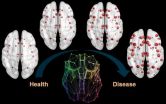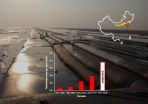Deep-earth carbon offers clues on origin of life on Earth
Johns Hopkins-led team links new organic carbon species in deep fluids to the formation of diamonds -- and life itself
2014-11-20
(Press-News.org) New findings by a Johns Hopkins University-led team reveal long unknown details about carbon deep beneath the Earth's surface and suggest ways this subterranean carbon might have influenced the history of life on the planet.
The team also developed a new, related theory about how diamonds form in the Earth's mantle.
For decades scientists have had little understanding of how carbon behaved deep below the Earth's surface even as they learned more and more about the element's vital role at the planet's crust. Using a model created by Johns Hopkins geochemist Dimitri Sverjensky, he, Vincenzo Stagno of the Carnegie Institution of Washington and Fang Huang, a Johns Hopkins graduate student, have become the first to calculate how much carbon and what types exist in fluids at 100 miles below the Earth's surface at temperatures up to 2,100 degrees F.
In an article published this week in the journal Nature Geoscience, Sverjensky and his team demonstrate that in addition to the carbon dioxide and methane already documented deep in subduction zones, there exists a rich variety of organic carbon species that could spark the formation of diamonds and perhaps even become food for microbial life.
"It is a very exciting possibility that these deep fluids might transport building blocks for life into the shallow Earth," said Sverjensky, a professor in the Department of Earth and Planetary Sciences. "This may be a key to the origin of life itself."
Sverjensky's theoretical model, called the Deep Earth Water model, allowed the team to determine the chemical makeup of fluids in the Earth's mantle, expelled from descending tectonic plates. Some of the fluids, those in equilibrium with mantle peridotite minerals, contained the expected carbon dioxide and methane. But others, those in equilibrium with diamonds and eclogitic minerals, contained dissolved organic carbon species including a vinegar-like acetic acid.
These high concentrations of dissolved carbon species, previously unknown at great depth in the Earth, suggest they are helping to ferry large amounts of carbon from the subduction zone into the overlying mantle wedge where they are likely to alter the mantle and affect the cycling of elements back into the Earth's atmosphere.
The team also suggested that these mantle fluids with dissolved organic carbon species could be creating diamonds in a previously unknown way. Scientists have long believed diamond formation resulted through chemical reactions starting with either carbon dioxide or methane. The organic species offer a range of different starting materials, and an entirely new take on the creation of the gemstones.
INFORMATION:
The research is part of a 10-year global project to further understanding of carbon on Earth called the Deep Carbon Observatory. The work is funded by the Alfred P. Sloan Foundation.
ELSE PRESS RELEASES FROM THIS DATE:
2014-11-20
Twenty-five years ago this month, the countries that compose the United Nations reached a landmark agreement that laid the foundation for much-needed strengthening of children's rights and protections in nearly every country around the world.
Today, the Convention on the Rights of the Child remains the only formal global effort to improve children's rights and the most widely ratified human rights treaty in history. Only three U.N. member nations have not ratified the treaty: Somalia, South Sudan and the United States.
"The Convention on the Rights of the Child is a ...
2014-11-20
Ebola GP protein covers the virus' surface and is shed from infected cells during infection. A study published on November 20th in PLOS Pathogens reports that shed GP can trigger massive dysregulation of the immune response and affect the permeability of blood vessels
Ebola virus has seven genes. One of them, called GP, codes for two related proteins: a shorter secreted one and a longer one that spans the viral wall and sticks out of its surface. During virus infection, some of the surface GP is cut off by a human enzyme and is subsequently shed from infected cells. High ...
2014-11-20
Researchers from the Montreal Neurological Institute have used a model inspired by patterns of epidemic disease spreading to map how misfolded proteins propagate within the brain.
Proteins which fail to configure correctly (misfolded proteins) are associated with aging and several human neurodegenerative diseases, such as Alzheimer's. In research published in this week's PLOS Computational Biology, Yasser Iturria Medina and colleagues analyze over 700 individual Amyloid-beta proteins imaging datasets to conclude that the propagation of these misfolded proteins, associated ...
2014-11-20
An international team of researchers has shown that it may be possible to improve the effectiveness of the seasonal flu vaccine by 'pre-empting' the evolution of the influenza virus.
In a study published today in the journal Science, the researchers, led by the University of Cambridge, describe how an immunological phenomenon they refer to as a 'back boost' suggests that it may be better to pre-emptively vaccinate against likely future strains than to use a strain already circulating in the human population.
Influenza is a notoriously difficult virus against which to ...
2014-11-20
RIVERSIDE, Calif. - Yellow fever is a disease that can result in symptoms ranging from fever to severe liver damage. Found in South America and sub-Saharan Africa, each year the disease results in 200,000 new cases and kills 30,000 people. About 900 million people are at risk of contracting the disease.
Now a research team led by a biomedical scientist at the University of California, Riverside has determined that the yellow fever virus, a hemorrhagic fever virus, replicates primarily in the liver. Therefore, other organ failures that often follow in people with the ...
2014-11-20
During the development of mammals, the growth and organization of digits are orchestrated by Hox genes, which are activated very early in precise regions of the embryo. These "architect genes" are themselves regulated by a large piece of adjacent DNA. A study led by Denis Duboule, professor at the University of Geneva (UNIGE) and the Federal Institute of Technology in Lausanne (EPFL), Switzerland, reveals that this same DNA regulatory sequence also controls the architect genes during the development of the external genitals. The results published in Science magazine, indicate ...
2014-11-20
If you are an active senior who wants to stay younger, keep on running.
A new study involving the University of Colorado Boulder and Humboldt State University shows that senior citizens who run several times a week for exercise expend about the same amount of energy walking as a typical 20-year-old.
But older people who walk for exercise rather than jog expend about the same amount of energy walking as older, sedentary adults, and expend up to 22 percent more energy walking than the 20-something crowd. The study, led by Humboldt State Professor Justus Ortega, was published ...
2014-11-20
Animal teeth, bones and plant remains have helped researchers from Cambridge, China and America to pinpoint a date for what could be the earliest sustained human habitation at high altitude.
Archaeological discoveries from the 'roof of the world' on the Tibetan Plateau indicate that from 3,600 years ago, crop growing and the raising of livestock was taking place year-round at hitherto unprecedented altitudes.
The findings, published today in Science, demonstrate that across 53 archaeological sites spanning 800 miles, there is evidence of sustained farming and human ...
2014-11-20
China's second great wall, a vast seawall covering more than half of the country's mainland coastline, is a foundation for financial gain - and also a dyke holding a swelling rush of ecological woes.
A group of international sustainability scholars, including Jianguo "Jack" Liu, director of Michigan State University's Center for Systems Integration and Sustainability, in a paper published today in Science magazine, outline the sweeping downsides of one of China's efforts to fuel its booming economy, downsides that extend beyond China.
China's coastal regions are only ...
2014-11-20
The Himalaya features some of the most impressive gorges on Earth that have been formed by rivers. The geologic history of the famous Tsangpo Gorge, in the eastern Himalaya, now needs to be rewritten.
A team of German, Chinese, and American geoscientists have namely discovered a canyon, filled with more than 500 m of sediments beneath the bed of the present-day Yarlung Tsangpo River upstream from the gorge. Using drill cores, the scientists were able to reconstruct the former valley floor of this river, which allowed them to reconstruct the geological history of the Tsangpo ...
LAST 30 PRESS RELEASES:
[Press-News.org] Deep-earth carbon offers clues on origin of life on Earth
Johns Hopkins-led team links new organic carbon species in deep fluids to the formation of diamonds -- and life itself





